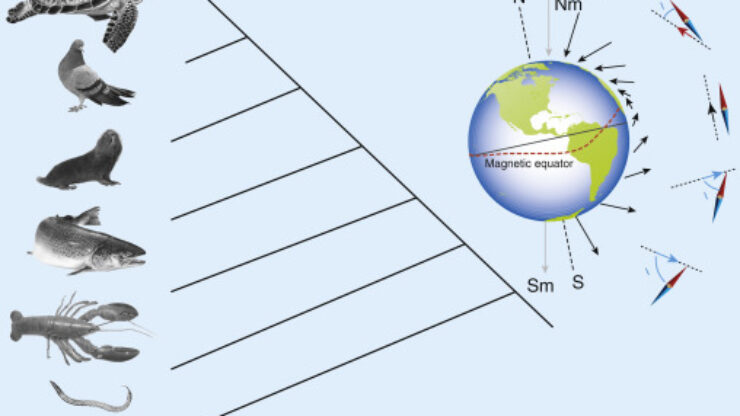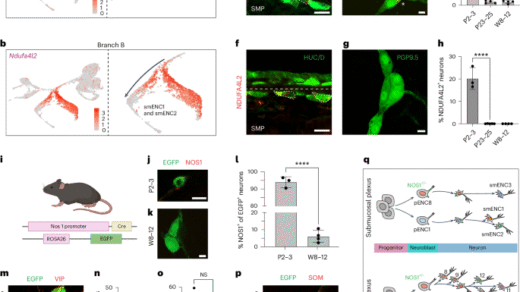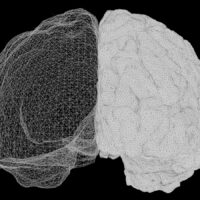Animals Navigate Using Earth’s Magnetic Field
Many animals possess a magnetic sense, allowing them to navigate using Earth’s geomagnetic field.
This ability, known as magnetoreception, is crucial for various species, from migratory birds and amphibians to fish and mammals.
Let’s understand how these animals detect and utilize the Earth’s magnetic field helps us uncover the complexities of their navigation strategies.
In this comprehensive exploration, we delve into the behavioral evidence, underlying mechanisms, and challenges in studying magnetoreception, offering a detailed understanding of this fascinating sensory ability.
Understanding Animal Magnetoreception
Behavioral Studies
Migratory Birds
– Migratory Unrest (Zugunruhe):
During migratory periods, captive birds exhibit restless behavior, aligning themselves in the direction they intend to migrate. This behavior indicates an innate sense of orientation. When the magnetic field around them is artificially altered, birds adjust their orientation, demonstrating their reliance on magnetic cues.
– Orientation Experiments:
Birds placed in circular cages or Emlen funnels show a clear preference for orienting themselves according to the magnetic field. These experiments confirm that birds can detect and respond to changes in the magnetic field , adjusting their migratory direction accordingly.
This behavior is consistent across various species of migratory birds, suggesting a widespread and robust mechanism for magnetoreception.
Amphibians and Mammals
– Amphibians:
Salamanders and frogs use the magnetic field for orientation, particularly when they need to find the nearest shore to escape threats.
Experiments have shown that altering the magnetic field can change the direction in which these amphibians move, underscoring their sensitivity to geomagnetic cues.
– Mole-Rats:
Experiments involving anesthetizing or surgically removing the eyes of mole-rats show that these animals lose their magnetic responsiveness, suggesting a magnetite-based receptor in the cornea. This finding highlights the diversity of magnetoreception mechanisms across different animal groups.
– Migratory Bats and Pigeons:
Numbing the cornea in bats and performing anesthesia or surgery on the trigeminal nerve in pigeons disrupts their magnetic field detection, indicating a potential magnetite-based sensor in the upper beak.
These studies suggest that multiple sensory systems may be involved in magnetoreception, with different species relying on distinct anatomical structures.
Mechanisms of Magnetoreception
Three primary mechanisms have been proposed for how animals might detect weak magnetic fields (approximately 0.5 Gauss):
1. Mechanical Reception:
This mechanism is similar to how a compass needle operates. It involves magnetic particles like magnetite in animals acting as magnetoreceptors.
Magnetotactic bacteria align with magnetic fields due to the torque on their magnetite particles. Similar mechanisms are proposed in animals, such as birds and fish, where magnetite particles in specialized cells might detect magnetic fields and send signals to the nervous system.
2. Electric Induction:
Movement in a magnetic field can induce an electric field.
Certain fish, such as elasmobranchs (e.g., sharks and rays), possess sensory organs capable of detecting these electric fields, thereby perceiving magnetic fields. This mechanism, however, is not found in all magneto-receptive animals.
The ampullae of Lorenzini, specialized electrosensory organs in these fish, detect the induced electric fields and help them navigate using geomagnetic cues.
3. Chemical Reception:
Magnetic fields can influence chemical reactions, such as radical-pair reactions.
Experiments have shown that even weak magnetic fields can alter the outcomes of these reactions, suggesting a chemical basis for magnetoreception. This mechanism might be widespread among animals, offering a versatile and sensitive means of detecting magnetic fields.
The Radical-Pair Mechanism
Cryptochromes
A leading theory involves radical pairs—quantum-entangled molecules with unpaired electrons. Proteins known as cryptochromes, present in the eyes of birds, form radical pairs upon activation by light.
When an electron transfers between molecules, creating unpaired electrons, their quantum spins are influenced by magnetic fields. This affects the duration of the radical pair’s existence. The cryptochromes are sensitive to the orientation and intensity of the Earth’s magnetic field, allowing birds to sense geomagnetic cues visually.
Cryptochromes allow birds to sense magnetic fields visually, integrating this information with other sensory inputs for navigation.
Cryptochromes are photoreceptor proteins found in organisms ranging from plants to animals, including birds.
They play a crucial role in the ability of birds to sense Earth’s magnetic fields, a capability that aids in navigation during migration.
– Cryptochromes are a type of flavoprotein, meaning they contain a chromophore (a light-absorbing molecule) that is sensitive to blue light.
– In birds, the specific type of cryptochrome involved in magnetoreception is cryptochrome 1a (Cry1a).
Light Sensitivity:
– Cryptochromes can be activated by blue light (wavelengths around 470-500 nm).
– In birds, exposure to blue light triggers a series of chemical reactions within the cryptochrome protein.
Magnetoreception Mechanism:
– When a bird is exposed to blue light, cryptochrome molecules in specialized cells in the bird’s eye (likely in the retina) become activated.
– This activation causes pairs of electrons within the cryptochrome protein to become entangled, a quantum phenomenon known as quantum coherence.
– The Earth’s magnetic field can influence the spin state of these entangled electrons due to a quantum effect known as the Zeeman effect, where magnetic fields can split energy levels.
– This process essentially allows the bird to “see” or perceive the direction of the magnetic field lines.
Impact:
– Birds use this magnetic sense for navigation, especially during migration.
– It helps them maintain a sense of direction over long distances, even when landmarks or visual cues are not available.
Research and Confirmation:
– Experimental evidence supporting the role of cryptochromes in magnetoreception includes studies where disrupting the cryptochrome protein or altering the magnetic field affected the bird’s ability to navigate accurately.
– Birds with genetically altered cryptochromes or those exposed to certain wavelengths of light that affect cryptochrome function show impaired navigation abilities.
Recent Discoveries
– Triplet State Radical Pairs:
Chris Bialas and his team proposed that radical pairs formed from the triplet state (where both electrons have the same spin) could be essential for magnetoreception. In this state, radical pairs are less reactive and operate over longer periods, which is crucial for magnetic sensing. This discovery enhances our understanding of the biochemical basis of magnetoreception and opens new avenues for research.
In the intricate world of avian navigation, scientists have delved into a fascinating phenomenon triplet state radical pairs.
These molecular structures, housed within cryptochrome proteins in bird retinas, play a crucial role in detecting Earth’s magnetic fields. When exposed to sunlight, cryptochromes undergo a photochemical reaction where a pair of electrons enters a quantum entangled state known as a triplet state radical pair.
The Earth’s magnetic field influences the spin of these entangled electrons through a phenomenon called the Zeeman effect. This interaction provides birds with a unique biological compass, allowing them to perceive the magnetic field lines. This ability is essential for their impressive navigation skills, enabling them to migrate across continents with precision, even in the absence of visual landmarks.
Research has shown that disrupting cryptochrome proteins or altering magnetic fields can impair a bird’s navigational abilities, underscoring the critical role of triplet state radical pairs in avian magnetoreception. This discovery not only showcases nature’s intricate use of quantum mechanics but also opens new avenues for understanding the intersection of biology and physics in the animal kingdom.
Magnetite-Based Receptors
Location and Function
– Upper Beak in Birds:
Some studies suggest that magnetite-based receptors in the upper beak of birds help detect the Earth’s magnetic field. These receptors might interact with the magnetic field, sending signals to the brain to aid in orientation. This mechanism could complement the radical-pair mechanism, providing birds with multiple means of detecting geomagnetic cues.
– Trigeminal Nerve Studies:
Anesthesia or surgery on the trigeminal nerve in birds disrupts their ability to detect magnetic fields, indicating a potential magneto receptive site in the upper beak.
However, identifying specific magnetite structures in this area remains elusive. Further research is needed to pinpoint the exact anatomical and cellular structures involved in magnetoreception.
Challenges in Understanding Animal Magnetoreception
Identifying Receptor Locations
Locating the exact site of magnetoreceptors in animals has been challenging. Initial studies suggested various sites, but subsequent research often raises doubts. The diverse mechanisms of magnetoreception across different species add to this complexity.
Techniques like surgical removal of presumed magnetic sensing organs or genetic manipulation (e.g., silencing the Cry gene in invertebrates) help locate an animal’s magnetic sense. However, these methods raise ethical concerns and may have non-specific effects.
Ethical Considerations and Techniques
Animals sense Earth’s magnetic fields involves intricate techniques and ethical considerations. Researchers often surgically manipulate presumed magnetic sensing organs, aiming for precise experimental control. However, such invasive procedures raise ethical concerns regarding animal welfare and potential impacts on natural behavior.
Anesthesia is an alternative, less invasive approach to immobilize animals during experiments.
Yet, it can have short-lasting effects and may interfere with sensory perception, complicating behavioral observations. Striking a balance between scientific rigor and ethical standards is essential in magnetoreception research.
Scientists must navigate these complexities to advance our understanding while ensuring human treatment of study subjects and minimizing any adverse effects on their natural behaviors and environments.
Experimental Limitations
– Magnetic Coil Systems:
Helmholtz or Merritt coils can manipulate the Earth’s magnetic field for experiments. These setups, while powerful, are spatially limited, restricting the range of behaviors that can be tested. Larger, more naturalistic environments are needed to fully understand how animals use magnetic fields in the wild.
– Stress Responses:
Sudden changes in magnetic fields can cause stress responses in animals, potentially confounding experimental results. For example, diurnal animals kept in the dark may display unusual orientations due to stress. Understanding and mitigating these stress effects is crucial for accurate observations.
– Human Impact:
Unusual magnetic field changes, such as those experienced by astronauts, can have psychophysiological impacts on humans, suggesting similar effects might occur in animals.
Studies on the human perception of magnetic fields could offer analogies for understanding animal magnetoreception.
Artificial Magnetoreception
Researchers have created an artificial protein mimicking natural cryptochromes to test magnetosensitivity.
This proteinu sing just one tryptophan and flavin, demonstrated functional magnetoreception at room temperature.
This showcases the potential to design minimal artificial compounds that mimic biological receptors. Such artificial systems provide controlled environments to study the principles of magnetoreception and could lead to novel technological applications.
Electronic skins (e-skins) are advancing with integrated sensors and actuators, designed to seamlessly merge with daily life. These devices, flexible and barely noticeable, replace rigid interfaces and enhance user-device interactions. Magnetic sensors in e-skins enable touchless interactions, moving beyond traditional tactile methods. Previous approaches relied on cumbersome setups like implanted magnets or bulky equipment.
Flexible magnetosensitive e-skins are now emerging, facilitated by shapeable electronics. These promise artificial magnetoreception without invasive procedures. Various sensor technologies such as giant magnetoresistance (GMR) and spin valves are employed, functioning comfortably on the skin without external magnetic biasing.
A recent breakthrough involves a highly compliant e-skin compass using geometrically conditioned anisotropic magnetoresistive (AMR) sensors. It significantly improves detection of Earth’s geomagnetic fields while maintaining mechanical durability. This innovation opens doors for applications in human orientation and virtual reality interaction.
Astrobiology Implication
Magnetoreception could also be significant for astrobiology.
On planets with stronger or less shielded magnetic fields, extraterrestrial organisms might use magnetoreception to locate resources or avoid toxic substances. This sensory ability could also aid in predator evasion or hunting.
Studying magnetoreception on Earth provides a framework for understanding how life might adapt to different planetary environments, expanding our search for extraterrestrial life.
Engage with Us:
Stay tuned for more captivating insights and News. Visit our Blogs and Follow Us on social media to never miss an update. Together, let’s unravel the mysteries of the natural world


















